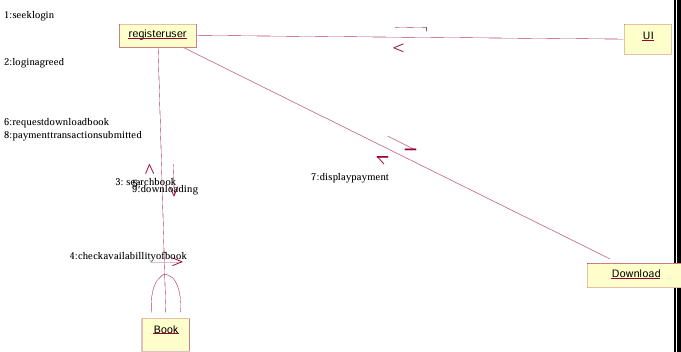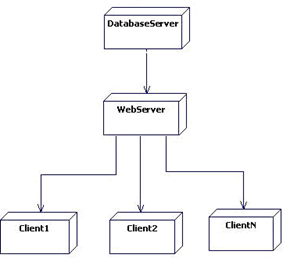E-book Management System
Aim: To create a system to perform E-book Management System.
(I) Procedure: Problem statement
E Book process is well organized online buying and selling of books. This system is well developed in various resources, for example, Amazon site deals more about e-booking concept. This process has various issues in the basics of maintenance of database and updating in sites, and virus problem in pdf books, so we have many issues in this process. The process of e-books is fully based on online, and the process for this mainly interaction between buyer and seller, buyer who enter the site for purchase of book will use search engine for book to purchase, the search engine will mainly focused on the database process, it used to search book for the buyer who mentioned the book name, author name, edition, publication details in the site, so that the search engine will show many books. There will be a payment option and option for pdf file or hardcopy delivery to home, the user should decide whether he wants which one. Whether he chooses hardcopy means, full detail address, driving license no, and then he should login with his username and password, and then payment through atm debit or credit card applicable.
(II) Software Resource Specification
Introduction
E-Book is the interface between the students and Librarian. It aims at improving the efficiency in the Issue of books or magazines and reduces the complexities involved in it to the maximum possible extent.
If the entire process of ‘Issue of Books or Magazines’ is done in a manual manner then it would take several months for the books or magazines to reach the applicant. Considering the fact that the number of students for Book Bank is increasing every year, an Automated System becomes essential to meet the demand. So this system uses several programming and database techniques to elucidate the work involved in this process. The system has been carefully verified and validated in order to satisfy it.
Scope
The System provides an online interface to the user where they can fill in their personal details and submit the necessary documents (may be by scanning). The authority concerned with the issue of books can use this system to reduce his workload.
Definitions, acronyms and the abbreviations
- E-book manager: Refers to the super user who is the Central Authority who has been vested with the privilege to manage the entire system.
- User: One who wishes to obtain the Books or Magazines.
- Visitor: One who visits to obtain Books or Magazines.
- Administrator: One who manages and maintains Books or Magazines.
IEEE Software Requirement Specification format
Technologies to be used
- HTML: Markup Language used for creating web pages.
- J2EE: Java2 Enterprise Edition is a programming platform and it is the part of the java platform for developing and running distributed java applications.
- HTTP: Hyper Text Transfer Protocol.
- TCP/IP: Transmission Control Protocol/Internet Protocol is the communication protocol used to connect hosts on the Internet.
Tools to be used
- Eclipse IDE (Integrated Development Environment).
- Rational Rose tool (for developing UML Patterns).
Overview
SRS includes two sections: overall description and specific requirements.
Overall description will describe the major role of the system components and inter-connections.
Specific requirements will describe roles & functions of the actors.
Overall description
It will describe the major role of the system components and inter-connections.
Product perspective
The ORS acts as an interface between the user and the ‘e-book manager’. This system tries to make the interface as simple as possible and at the same time not risking the security of data stored in. This minimizes the time duration in which the user receives the books or magazines.
Software interface
- Front End Client: The Student and Librarian online interface is built using JSP and HTML. The Librarian’s local interface is built using Java.
- Web Server: Apache Tomcat application server (Oracle Corporation).
- Back End: Oracle 11g database.
Hardware interface
The server is directly connected to the client systems. The client systems have access to the database in the server.
System functions
- Secure Registration of information by the Students.
- Librarian can generate reports from the information and is the only authorized personnel to add the eligible application information to the database.
User characteristics
- User: They are the people who desire to obtain the books and submit the information to the database.
- Visitor: They are the person who visits the E-book system.
- Administrator: He has certain privileges to add the books and to approval of the reservation of books.
Constraints
- The Students require a computer to submit their information.
- Although the security is given high importance, there is always a chance of intrusion in the web world which requires constant monitoring. The user has to be careful while submitting the information. Much care is required.
Assumptions and dependencies
- The user and e-book manager must have basic knowledge of computers and English Language. The user may be required to scan the documents and send.
(III) Use-Case Diagram
The E-book use cases in our system are:
- Login
- Register
- Search book
- Download
- Payment
- Publisher
- Update
Actors involved:
- Register User
- Visitor
- Administrator
1. Add:
A student record. Each student should have the following attributes:
- Student id
- Name
- Address
- Phone no
2. Update:
The record would be selected using the student id. The updates can be made on full items only:
- Name
- Address
- Phone no
3. Add to book item:
Each book should have the following attribute.
4. Query the book database:
The product shall let the librarian query tools books detail information by their ISBN number (or) author (or) title. The search result would produce a list of books, which match the search parameters.
5. Checkout a book:
Librarians and members of the library can check out can be initialized from a previous search operation where the user has selected a set of books.
6. Check in a book:
Librarians and members of the library can check in a book using its call no.

Activity Diagram
The activity diagram shows the activity of the process. Here first login is done when the user is valid then the welcome page appears. Here fork is used where two transaction lines may be got: search book and online reading.
Search book can be used to search book and online reading can allow the user to learn online and when any of these two processes is selected a join is used where download occurs. In this download of the book is done then finally the cost of the book is paid online.

Class Diagram
The class diagram, also referred to as object modeling, is the main static analysis diagram. The main task of object modeling is to graphically show what each object will do in the problem domain. The problem domain describes the structure and the relationships among objects.
The E-book Management system class diagram consists of five classes:
- Login
- Registered User
- Administrator
- Book
- Visitor
- Download
- Logout
Login:
Login to the system.
Registered User:
It consists of six attributes and four operations. The attributes are:
- User id
- Name
- Password
- Email id
- Phone no
- Security question
The operations of this class are:
- download()
- login()
- search()
- register()
Administrator:
It consists of four attributes and two operations. The attributes are:
- Name
- Password
- Email id
- Admin id
The operations of this class are:
- update()
- record()
Book:
It consists of four attributes and two operations. The attributes are:
- Book id
- Book name
- Author
- Price
The operations of this class are:
- update()
- add()
Visitor:
It consists of two attributes and two operations. The attributes are:
- User name
- Email id
The operations of this class are:
- search book()
- read book()
Logout:
Logout from the system.

Interaction Diagram
A sequence diagram represents the sequence and interactions of a given USE CASE or Sequence diagram scan capture most of the information about the system. Most object-to-object interactions and operations are considered events and events include signals, inputs, decisions, interrupts, transitions, and actions to or from users or external devices.
An event also is considered to be any action by an object that sends information. The event line represents a message sent from one object to another, in which the “from” object is requesting an operation be performed by the “to” object. The “to” object performs the operation using a method that the class contains.
It is also represented by the order in which things occur and how the objects in the system send messages to one another. The two sequence diagrams and two collaboration diagrams, one for Registered user and another for visitor, are given. The diagrams show first login to the system and the pin no is entered and check the pin. Get no and valid at e password check the condition based on condition book issue and return is done. Pay the online and renewed finally logout from the system.




State Chart Diagram
The diagrams show first login to the system and view the books and search for the required book is done and then the required book is downloaded and amount paid online. Finally, logout from the system.

Deployment Diagram and Component Diagram
Deployment diagrams are used to visualize the topology of the physical components of a system where the software components are deployed.

Component Diagram
Component diagrams are used to visualize the organization and relationships among components in a system.

